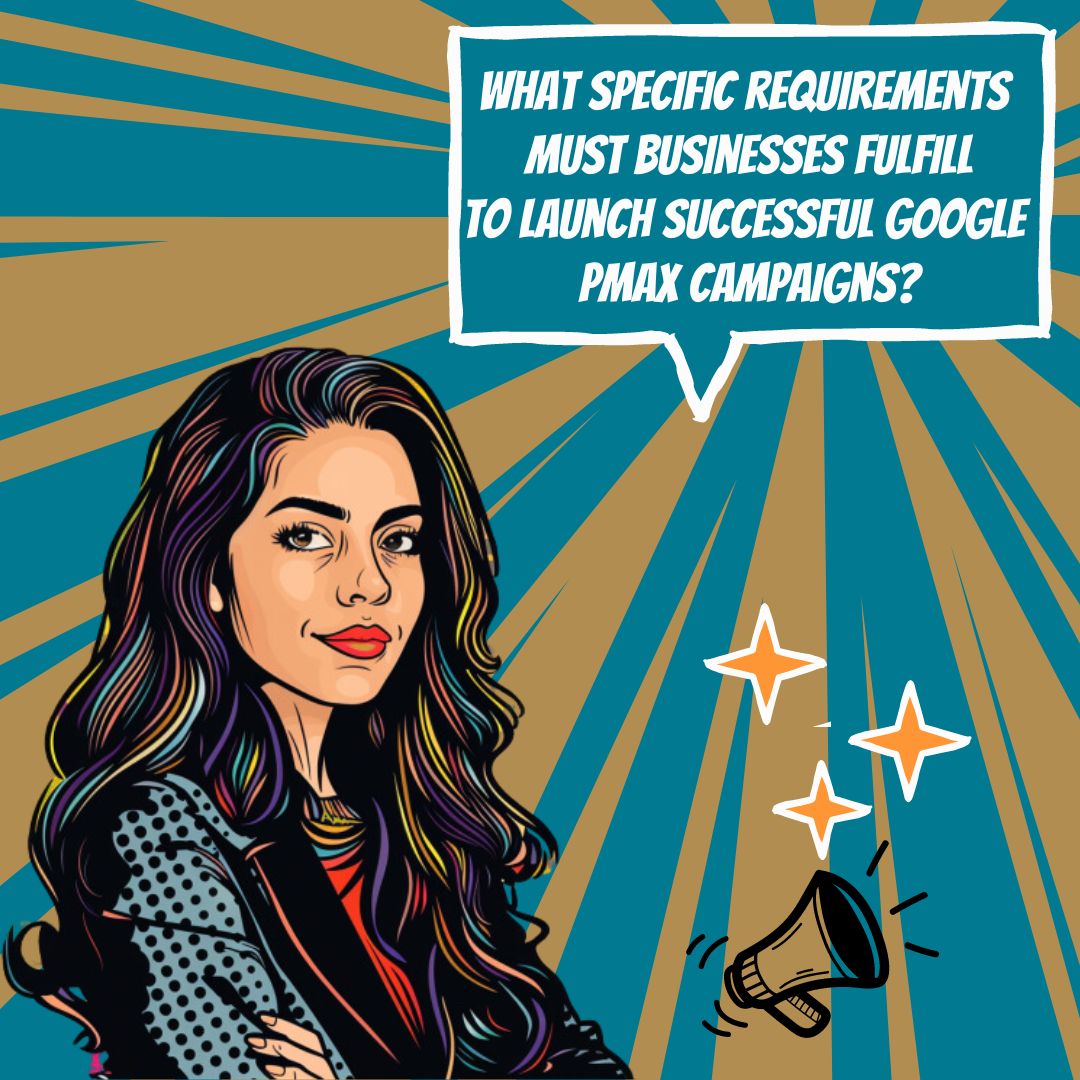Key Takeaways
✅ Eligibility and Prerequisites: Starting a Google Performance Max campaign isn't just a walk in the park. You need a few things in order before you take off. Got a Google Ads account and a Merchant Center account that shake hands? What about a domain that says 'Yes, that's really me'? And let's not forget about tracking conversions – because flying blind won’t get you far. Make sure you're decked out with the basics, and have some data for Google's clever algorithms to chew on.
✅ Campaign Assets: Think of your campaign assets like your fishing gear when you're hoping for a big catch. You'll want a tackle box with crisp headlines, descriptions that hook, and images and videos so good they reel 'em in. Remember, Google's pretty strict with what goes up on their billboards, so keep it clean and relevant. High-quality gear calls for bigger fish – or in advertising speak, better performance.
✅ Goals and Targeting: Goals are your destination on the map. Without them, where are you heading? Pin them down. Do you want more visitors, more sales, or just to be the talk of the town? Whisper this into Google's ear through the right audience signals. It's like teaching a dog new tricks; guide it carefully with your location, language and money pouch settings. Keep an eye on it, tweak when needed, and watch your pup—err, campaign—fetch you the results you want.

Introduction
Ever stared at Google PMax and thought, 'How on earth do I master this beast?' You're not alone. Launching a successful campaign can feel like you're trying to tame a wild stallion. It takes more than just a quick hop on; it's knowing the reins, the saddle, and having the grit to hold on.
What makes Google PMax the stallion of the ad world? Well, it's the powerhouse that runs your ads across all corners of Google's vast empire - from the search pages to the mysterious depths of YouTube. But how do you saddle up this stallion for a winning ride?
That's exactly what we're diving into – preparing, not just with a checklist, but with the know-how to ride all the way to the victory lap of marketing success. And I'm not just talking about ticking off a to-do list. We're going to uncover some gold nuggets of wisdom to really rev up your ROI, boost your revenue, and maybe, just maybe, become the name everyone can't stop talking about. Stick around, because you're about to get the must-have insights that could skyrocket your campaign to stellar heights.
Top Statistics
| Statistic | Insight |
|---|---|
| Adoption Rate: 70% of advertisers have adopted PMax campaigns. (Source: Merkle) | Shows the growing trust in PMax campaigns among advertisers – are you keeping up with the trend? |
| Conversion Rates: Average 11.7% across industries, with financial services at a high of 18.4%. (Source: Wordstream) | Indicates PMax's effectiveness in turning viewers into customers, especially in lucrative sectors. |
| Click-Through Rates (CTR): Average CTR is 1.5%, with travel industry peaking at 2.4%. (Source: Wordstream) | Understanding CTRs can help you benchmark your campaigns and strive for those top-performing clicks. |
| Return on Ad Spend (ROAS): Average ROAS is $4.74, retail industry leading with $6.11. (Source: Wordstream) | Highlights how PMax campaigns can be a profitable investment, especially if you're in retail. |
| User Demographics: 60% of millennials and Gen Z prefer online shopping. (Source: Think with Google) | Targeting the right audience is crucial, and PMax can help you reach the digital-native generations where they're most active. |
Understanding Google Performance Max (PMax) Campaigns
Have you ever heard about Google's Performance Max (PMax) campaigns and wondered what all the fuss is about? At their core, they're about helping you reach more customers across Google’s channels and networks - from Search to YouTube, from Gmail to Maps. They're designed to work wonders for businesses chasing goals like boosting sales, leads, or even increasing store visits. But what makes them tick? It's Google's magic recipe of automation and your custom inputs, creating ads that reach potential customers at just the right moment.
Navigating the Prerequisites for Google PMax
Before diving into a PMax campaign, you've got to tick some boxes. Eligibility criteria is the starting line, and you've got to have a Google Ads account that's shipshape to join the party. Think of it as getting an exclusive club membership – if your Google Ads account has been playing by the rules and staying out of trouble, you're ready to rock.
Essential Campaign Setup Requirements
When you're setting things up, think of it like planning a journey. Where do you want to go? That's like choosing your campaign goal. Next up, how much fuel do you need for the trip—that's your budget. And the route? That's where Google's smart bidding comes into play. Add in some ad groups, fill up on relevant info, and you're in the driver's seat, ready for an adventure.

Gathering Your Asset Arsenal
Convincing folks to stop and shop is all about the wow factor. That's where assets come into play. You'll need eye-catching images and videos and some snappy headlines to reel them in. But the secret ingredient is what Google calls audience signals; using customer lists and such to whisper to Google's algorithms, "Hey, these are the folks I want to join my party." Don't forget the URLs, because you've got to lead your guests to the right place, and tracking URLs to keep score of your shindig's popularity.
Unleashing Optimization Tips
Once the party's started, you want to keep the energy high. Regularly monitoring performance metrics is like keeping an eye on the snacks table – refill what's running low and swap out the unpopular dips. Get creative, mix and match assets, and seek out Google’s advice with automated insights to keep the vibe alive.
The Nitty-Gritty of Measurement and Reporting
Ever thrown a bash and wondered if folks actually had a good time? That's where conversion tracking and smart attribution models step in. They help you understand who's turned up because of your PMax campaign and how much they contributed to the fun. Layer on some Google Ads reporting tools, maybe even a dollop of analytics platforms, and you've got a clear picture of your party's success.
So there we have it—a throw-down on PMax campaigns. Now, just between us, doesn't it get your gears turning, thinking about the kind of campaigns you could be running? Are you itching to gather your assets and kick off this adventure? Sure, there might be a bit of learning and tweaking, but aren't the potential rewards worth the shot? And remember, just like marketing trends, this stuff keeps evolving, so stay sharp and don't miss those updates from Google. Your next campaign might just be your best one yet!

AI Marketing Engineers Recommendation
Recommendation 1: Diversify Your Asset Groups with High-Quality Content: Before you leap into Google's Performance Max campaigns, create various high-quality images, videos, and texts for your asset groups. These assets are the building blocks of your ads, and you'll need them to be versatile and engaging. Think about what grabs your attention when you're scrolling online. That's the kind of content that can stop a potential customer in their tracks too. Google uses machine learning to mix and match these assets to serve the best-performing ad combinations. Make sure each picture tells a story, and every video snippet shares a chapter of your brand's tale. You don't just want views; you want memories made with your brand at the center.
Recommendation 2: Set Concrete Goals and Measure Them with the Right Metrics: Before you dive into the Performance Max pool, know what you're looking to achieve. Do you want more eyes on your site, more items in shopping carts, or are you after the sound of registers ringing with sales? Set clear, measurable goals. Google PMax thrives on specific ‘conversion goals’ set within your campaign, which inform the AI on how to optimize your ads. Use current trends like measuring Customer Lifetime Value (CLV) or Return On Ad Spend (ROAS) and watch these numbers closely. They're the scorecard of your game in the marketing field.
Recommendation 3: Embrace the Power of Audience Signals to Guide the AI: To help Google's AI, think about who would love your product. Performance Max requires you to provide 'audience signals.' These are a bit like giving the AI a starting point before it begins its magic of finding you new customers. Use data from your website analytics, CRM, or even educated guesses if you're just starting. The clearer your signals, the better Google will be at finding customers who'll flock to you like bees to a blossoming flower. Remember, the AI is smart, but it's your insights that can give it the best start.
Relevant Links
- Revolutionize Digital Marketing with AI
- AI-Driven Marketing for Affiliate Success
- Maximize ROI with Google Ads: Strategies for Success
- Unleashing the Power of ChatGPT for Business Growth
- Leverage AI for Innovative Content and Engagement
Conclusion
Well, we've journeyed through the ins and outs of Google PMax campaigns, haven’t we? It’s a bit like preparing for an adventure, making sure we've got everything we need before we set off. So, let's take a moment, shall we, to reflect on the essentials for a successful campaign.
Having your Google Ads account all tidy and in good standing is a bit like having a passport ready for travel – it’s the starting line. Choosing your campaign goal is like picking your destination, while your budget and bidding strategy are your travel funds – essential, but require careful management to get you where you want to go.
Remember those assets we talked about? Quality images, catchy headlines, those trusty audience signals – they’re your travel gear. Without them, well, your campaign might just feel a bit underdressed. And don’t forget about measurement and reporting. It’s like sending postcards back home; it tells you and everyone else where you’ve been and what you've accomplished.
Now, have you thought about the fears of starting a campaign? What if it doesn't work out? That’s where the beauty of monitoring and optimization comes into play. Keeps any misadventures at bay, doesn’t it?
And our hopes? They’re all about reaching those campaign goals, leading to celebratory dances because our groundwork led to success. It's all about using these stepping stones – optimizing PMax campaigns, utilizing insights, testing, and refining. Isn’t that exciting?
As we wrap up, let’s stay curious, keep learning, and remember to keep a close watch on Google's updates and best practices. They change like the weather! Ready to embark on this PMax campaign journey? Your brand's story is waiting to be told on a grand stage, and now, you know just how to set that stage up for a standing ovation.

FAQs
Question 1: What is Google PMax, and how does it work?
Answer: Google PMax is a type of campaign that uses machine learning to show your ads on platforms such as Search, Display, YouTube, and more. It focuses on getting you leads or sales by pinpointing the right people and displaying your ads when it matters most.
Question 2: What do you need to start a Google PMax campaign?
Answer: You'll need a Google Ads account with conversion tracking set up, and if you’re selling stuff, a Google Merchant Center account. Make sure you have at least one active conversion action ready to go.
Question 3: How can you nail a PMax campaign from the get-go?
Answer: Set your campaign goals clearly, use top-notch images, videos, and text, and tell Google who you want to reach with audience signals. Also, a mobile-friendly and quick-loading website is key.
Question 4: What kinds of images and videos do you need for PMax?
Answer: Gather at least five headlines and descriptions, a square image, a landscape image, and a video that's not too long but not too short—think Goldilocks!
Question 5: What's the deal with bidding in PMax?
Answer: PMax uses Smart Bidding to figure out how much to bid for a likely conversion. You can pick strategies aimed at getting more conversions, staying within a cost per action, focusing on return on ad spend, or simply getting more clicks.
Question 6: How does PMax find the right audience for your ads?
Answer: It looks at traits like demographics and interests to find your ideal customers. You can tell it to look for more people like your audience to expand your reach too.
Question 7: Does PMax fine-tune where and how your ads show up?
Answer: Yes, it automatically adjusts where your ads appear and their format to hit your campaign targets.
Question 8: How can you tell if your PMax campaign is rocking it?
Answer: Keep an eye on the number of conversions, the value they bring, and your return on ad spend. Google Analytics is also a goldmine for understanding how users interact with your site.
Question 9: Got any secrets for making PMax campaigns even better?
Answer: Sure do! Keep your content fresh and exciting, continue to tell Google about your audience, and stay on top of your bid strategies. And remember, a smooth experience on your website for mobile users is crucial.
Question 10: Are there next-level tactics for PMax aficionados?
Answer: You bet! Consider reaching beyond your usual crowd, creating custom groups of potential customers, and really getting into the data to see the whole picture of your customer’s journey. Automate with rules and scripts to streamline campaign management.

Academic References
- Google. (2020). Google Ads Performance Max: A New Paradigm for Smart Bidding. This foundational whitepaper outlines the innovative approach behind Google Performance Max campaigns. It underscores the role of machine learning in optimizing various aspects of advertising, from creative asset generation to selecting the right channel mix for maximum impact. The paper stresses that high-quality data inputs are crucial for leveraging the full potential of PMax. Available at Google's official repository.
- Fou, A. (2020). Performance Max: The Future of Google Ads? Forbes. Dr. Augustine Fou provides a critical analysis of PMax, considering both its advantages and potential drawbacks. His key advice revolves around the necessity for definitive campaign objectives, accurate convergence of relevant conversion events, and diligent tracking of performance metrics to fine-tune the campaigns effectively. A detailed read is available on Forbes website.
- WordStream. (2020). Google Performance Max: The Future of Smart Bidding? WordStream offers a pragmatic look at the functionality of PMax, shedding light on its potential for elevating conversion rates, broadening audience reach, and advancing campaign automation. Highlighting the cruciality of top-tier assets and meticulous setup of conversion tracking, this article uncovers nuanced strategies for reaping the benefits of PMax. It can be found on WordStream's blog.








